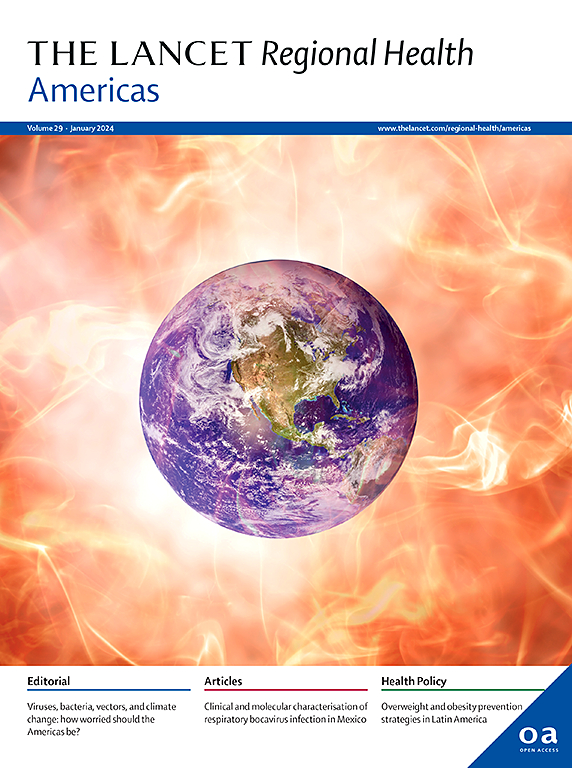哥伦比亚早发性乳腺癌妇女在两个时期的护理质量:来自全国行政登记队列的研究结果
IF 7
Q1 HEALTH CARE SCIENCES & SERVICES
引用次数: 0
摘要
早发性乳腺癌(early -onset breast cancer, EOBC)是指在18-45岁女性中诊断出的乳腺癌,多与遗传性乳腺癌综合征相关,诊断阶段较晚,预后较差。在本文中,我们试图在哥伦比亚国家卫生系统框架内描述EOBC的主要特征和护理质量。MethodsCross-sectional研究。我们使用了国家行政癌症登记处,包括2017年至2022年间诊断为EOBC的女性。按医疗保险计划分层,比较了两个时期(2017-2019年、2020-2022年)的人口统计学和临床特征以及优质医疗保健指标(数字和百分比)。研究结果包括7621名发生EOBC的女性,占研究期间报告的所有乳腺癌的19.4%(7621/39,238)。平均年龄为39.2岁(SD 5.2)。大多数病例(23%[1753/7621])诊断为IIA期。全身治疗是最常见的首次治疗。当比较这两个时期时,改善的主要领域与早期保乳手术有关(从60.3%[459/761]到68.3%[699/1024]),转移性癌症的姑息治疗(从29.5%[59/199]到54.9%[101/184]),以及等待时间的减少。从收集活检样本到收到结果的时间在两期之间的改善最大(从平均24.5天到5.0天)。然而,开始治疗的延迟持续存在,平均超过两个月。解释:虽然近年来哥伦比亚对患有乳腺癌的妇女的乳腺癌护理质量有所改善,主要是由于更好地获得特定技术和治疗,但在早期发现和保健服务延误方面存在重大挑战,需要采取纠正措施。资助:国际癌症研究机构/世卫组织的工作得到了经常预算资金的支持。本文章由计算机程序翻译,如有差异,请以英文原文为准。
Quality of care in Colombian women with early-onset breast cancer in two time periods: findings from a nationwide administrative registry cohort
Background
Early-onset breast cancer (EOBC) refers to breast cancer diagnosed in women aged 18–45 years, being in many cases associated with hereditary breast cancer syndromes, diagnosed at more advanced stages and worse prognosis. In this paper, we sought to describe the main characteristics of EOBC and quality of care within the framework of the national health system in Colombia.
Methods
Cross-sectional study. We used a national administrative cancer registry, including women diagnosed with EOBC between 2017 and 2022. Demographic and clinical characteristics, as well as quality healthcare indicators, were compared (numbers and percentages) over two periods (2017–2019, 2020–2022), stratified by health insurance scheme.
Findings
7621 women with incident EOBC were included, constituting 19.4% (7621/39,238) of all breast cancers reported in the study period. The mean age was 39.2 (SD 5.2). Most of the cases (23% [1753/7621]) were diagnosed at stage IIA. Systemic therapy was the most frequent first treatment. When comparing both periods, the main areas of improvement were related to breast-conserving surgery for early stages (from 60.3% [459/761] to 68.3% [699/1024]), access to palliative care for metastatic cancer (from 29.5% [59/199] to 54.9% [101/184]), and reduction of waiting times. The time from collecting biopsy samples to receiving results showed the biggest improvement between periods (from a mean of 24.5 to 5.0 days). However, delays in initiating treatment persist, with an average of over two months.
Interpretation
While the quality of breast cancer care in women with EOBC has improved in recent years in Colombia, mainly due to better access to specific technologies and treatments, there are important challenges regarding early detection and health services delays that require corrective measures.
Funding
Work at the IARC/WHO was supported by regular budget funding.
求助全文
通过发布文献求助,成功后即可免费获取论文全文。
去求助
来源期刊

Lancet Regional Health-Americas
Multiple-
CiteScore
8.00
自引率
0.00%
发文量
0
期刊介绍:
The Lancet Regional Health – Americas, an open-access journal, contributes to The Lancet's global initiative by focusing on health-care quality and access in the Americas. It aims to advance clinical practice and health policy in the region, promoting better health outcomes. The journal publishes high-quality original research advocating change or shedding light on clinical practice and health policy. It welcomes submissions on various regional health topics, including infectious diseases, non-communicable diseases, child and adolescent health, maternal and reproductive health, emergency care, health policy, and health equity.
 求助内容:
求助内容: 应助结果提醒方式:
应助结果提醒方式:


